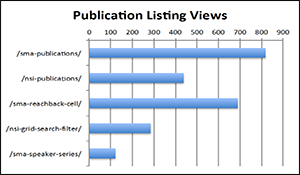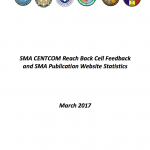SMA Reachback Feedback | SMA Publication Statistics

SMA CENTCOM Reach Back Cell Feedback and SMA Publication Website Statistics.
Author | Editor: SMA Program Office.
Feedback from CENTCOM
CENTCOM after receiving the Reach Back Cell Reports distributes them to the staff for their review and the reports ultimately are disseminated throughout the Command and placed on the “Strategic Studies” portal on the CENTCOM Homepage (under “Community of Interests”) and available for download and search by members of the Command. The NSI team also posts the reports on their website (URL above) and they are also searchable on the NSI website. There exists a feed-back loop on the SMA SIPR page. The command will solicit feedback from the various directorates and sub-Commands there and then distill a succinct response after reviewing each paper to give confidence that the findings have reached and been reviewed with the relevant Plan Teams. CENTCOM is also planning to conduct a survey and feedback from that survey will be disseminated. Feedback that has been provided so far included the following:
- These assessments bring added value for CENTCOM since at least they provide context and different perspectives. Most likely, these papers inform different divisions at a time depending on the subject.
- SMA products are geared for general planners, those that need to increase their knowledge on the region, and should be perused as a matter of professionalism.
- SMA is free, casts a wide net, and provides quality products – it is an excellent resource to address leaders questions that aren’t taken up in other venues. SMA products are a great starting point for those that need to brush up on prevailing expert opinion.
- The Operational Assessments Group (OAG) are a small group and are tasked to think bigger picture, like Weapons of Mass Destruction and Virtual Caliphate (projects that last weeks/months). For example, OAG provided the Commander with a lot of the information for the Virtual Caliphate article he published in the Center for a New American Security. SMA products are right in line with the types of information they process and for the types of projects they work on.
- The largest portion of the CENTCOM J2 is the Joint Intelligence Center (JIC), and most JIC analysts are geographic or regional experts who are tasked to provide mostly quick turn (1hr/1day) products based on SIGINT/HUMINT “intel facts.” The SMA info is generally too long and not directly traceable to intel facts to be plugged into their products.
- I think these assessments bring added value for CENTCOM since at least they provide context and different perspectives. We intend to read a few of the most recent reports and apply a bit of a checklist to key findings – determine what, could be/needs to be, purposefully tasked for inclusion in our campaign design or perhaps referred to other agencies for policy action – CCJ3 Plans.
SMA Publications Statistics
Strategic Multilayer Assessment (SMA) is a multidisciplinary, multi-agency portfolio of projects that assesses and studies challenging problems associated with planning and operations of DoD, military services, and Government agencies.
The SMA Publications is the collection of analytical reports, proceedings, white papers, and various other related materials that correspond to the multitude of SMA projects from 2007 to current date, all organized and metadata tagged to facilitate easy and efficient document discovery, retrieval, search and filtering.
The SMA Publications is hosted and maintained at NSI’s website. Below is the URL for the SMA Publications along with the URLs for various related publication listings:
- SMA publications: http://nsiteam.com/sma-publications/
- NSI publications archive: http://nsiteam.com/nsi-publications/
- Reachback Cell publications: http://nsiteam.com/sma-reachback-cell/
- SMA Speaker Series publications: http://nsiteam.com/sma-speaker-series/
- Grid Search | Filter tool: http://nsiteam.com/nsi-grid-search-filter/
Google Analytics – Google’s web analytics service – is used to track and report website traffic to the SMA Publications and Reachback Cell publication listings, along with traffic to some of the key publications found in those publication listings. Below is a summary of some of the website traffic for Feb 2017. In the charts that follow, a “view” corresponds to a pageview in Google Analytics parlance, which is the total number of times the page was viewed (note: repeat views of the page by a single user are each counted).

Comments